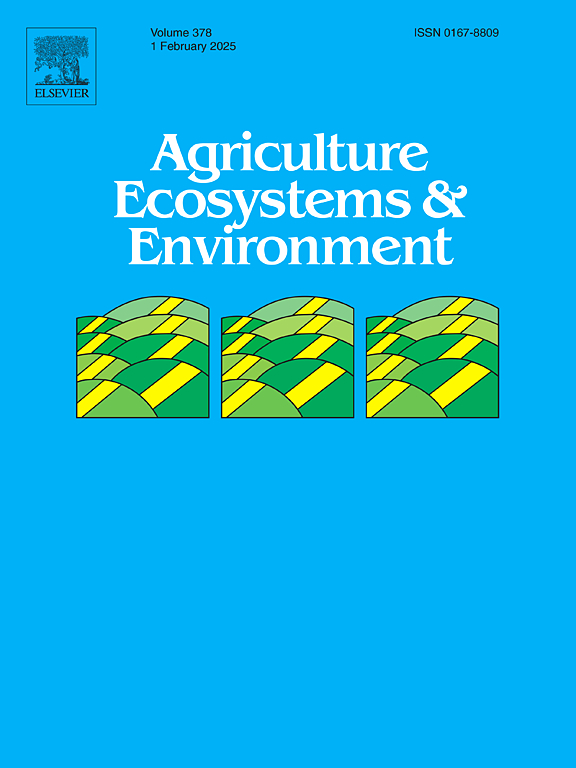保护性耕作增加了旱地的有机碳和无机碳:来自20年田间试验和荟萃分析的见解
IF 6
1区 农林科学
Q1 AGRICULTURE, MULTIDISCIPLINARY
引用次数: 0
摘要
保护性耕作被广泛认为是一种很有前途的固碳方法。然而,其对土壤无机碳(SIC)的影响尚不清楚,也很少被量化。本研究旨在研究保护性耕作对土壤碳库的影响,以SIC为重点,通过在中国干旱钙质农田进行20年的田间试验,并对来自7项研究的76个成对数据进行荟萃分析。田间试验证实,保护性耕作显著增加了土壤碳储量,其中免耕(NT)增加了土壤有机碳(25.09 %,0 ~ 40 cm),免耕(RT)增加了土壤有机碳(10.67 %,0 ~ 20 cm)。有机碳和碳化硅表现出一种互补关系,即有机碳的增加有效地补偿了土壤中碳化硅的减少。值得注意的是,钙化细菌(如芽孢杆菌)的增殖和脲酶活性的降低表明,微生物诱导的碳酸盐沉淀(已知由这些细菌促进的过程)可能对土壤中碳化硅的形成有重要贡献。农艺实践以及土壤非生物和生物因素共同影响碳化硅。这些因素的相对重要性随土壤深度的不同而不同:生物变量的影响随土壤深度的增加而减弱,而非生物变量的影响则增加。此外,我们的荟萃分析表明,SIC对保护性耕作的响应随气候、土壤和农艺因素而变化。干旱区利用NT增加SIC储量的效果最大(3.27 %)。这些发现为保护性耕作如何影响土壤碳,特别是SIC提供了有价值的见解,并增强了我们对干旱系统碳动态的理解。本文章由计算机程序翻译,如有差异,请以英文原文为准。
Conservation tillage enhances both organic and inorganic carbon in dryland: Insights from a 20-year field experiment and meta-analysis
Conservation tillage is widely recognized as a promising practice for sequestering soil organic carbon (SOC). However, its impact on soil inorganic carbon (SIC) remains less understood and has seldom been quantified. This study aimed to examine the effects of conservation tillage on soil carbon pools, focusing on SIC, by combining a 20-year field experiment in an arid-calcareous cropland of China with a meta-analysis of 76 pairwise data from 7 studies. The field experiment confirms that conservation tillage significantly increases carbon stock, with reduced tillage (RT) increasing SOC (25.09 %, 0–40 cm) and no-tillage (NT) increasing SIC (10.67 %, 0–20 cm). SOC and SIC exhibit a complementary relationship, whereby an increase in SOC effectively compensates for reduced SIC within RT. Notably, the proliferation of calcifying bacteria (e.g., Bacillus) and reduced urease activity suggest that microbial-induced carbonate precipitation, a process known to be facilitated by these bacteria, may contribute significantly to SIC formation under NT. Agronomic practices, as well as soil abiotic and biotic factors, collectively influence SIC. The relative importance of these factors varies with soil depth: biotic variables effects weaken with depth, while abiotic variables increase. Furthermore, our meta-analysis reveals that the response of SIC to conservation tillage varies with climatic, edaphic, and agronomic factors. Arid regions benefit the most from NT in enhancing SIC stock (3.27 %). These findings provide valuable insights into how conservation tillage influences soil carbon, particularly SIC, and enhance our understanding of carbon dynamics in arid systems.
求助全文
通过发布文献求助,成功后即可免费获取论文全文。
去求助
来源期刊

Agriculture, Ecosystems & Environment
环境科学-环境科学
CiteScore
11.70
自引率
9.10%
发文量
392
审稿时长
26 days
期刊介绍:
Agriculture, Ecosystems and Environment publishes scientific articles dealing with the interface between agroecosystems and the natural environment, specifically how agriculture influences the environment and how changes in that environment impact agroecosystems. Preference is given to papers from experimental and observational research at the field, system or landscape level, from studies that enhance our understanding of processes using data-based biophysical modelling, and papers that bridge scientific disciplines and integrate knowledge. All papers should be placed in an international or wide comparative context.
 求助内容:
求助内容: 应助结果提醒方式:
应助结果提醒方式:


